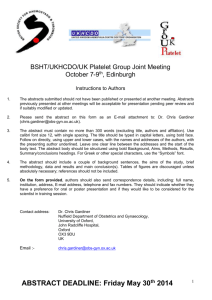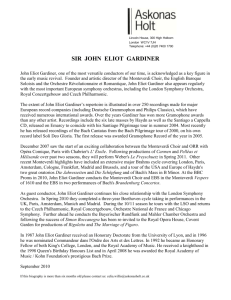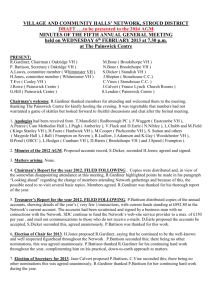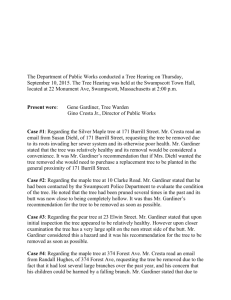FULL STUDY Read details on Gardiner study put
advertisement
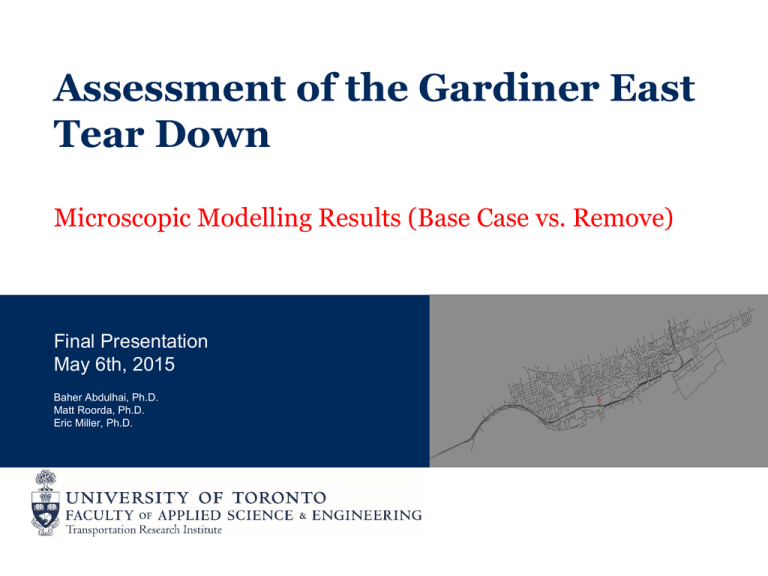
Assessment of the Gardiner East Tear Down Microscopic Modelling Results (Base Case vs. Remove) Final Presentation May 6th, 2015 Baher Abdulhai, Ph.D. Matt Roorda, Ph.D. Eric Miller, Ph.D. Executive Summary (1/2) Modelling traffic impact of removing the Gardiner between Jarvis and DVP Based on latest 2011/2012 demand data, traffic measurements and modelling approaches Regional level modelling to capture demand Study area detailed microsimulation modelling to capture travel times Three scenarios: • Base case / existing (2011/2012) • Remove option 1: traffic oriented boulevard • Remove option 2: pedestrian oriented boulevard Executive Summary (2/2) Key observations (base case vs. remove): – 7500 vehicles in the morning rush hour use the GE in the section to be removed – Insignificant change in demand from before to after – Performance of the boulevard depends on its design (traffic vs. pedestrian oriented) – Travel times between the Humber area and the DVP at Dundas increase by up to 10 min (50%) – Extra delay cost of ~$37M/year – DVP southbound traffic most affected near Richmond (1600 vehicle blocked outside the study area compared to 400 in the base case) Overall Modelling Approach Base Case Model Parameters Input Data …. Demand Data …… Microsimulation Model Outputs Observed Data Validation Verification Calibration Demand Calibration Tearing Down Gardiner Exp 4 Demand Analysis Demand Modelling Methods Demand and traffic data GTHA Demand Models (trucks and cars) Regional trip matrices Study Area Demand Models (trucks and cars) Gateway-to-gateway trip matrices Microscopic Freeway Simulation in Paramics 6 Key Features of Models For cars, GTAModel4 simulates route choice, mode choice, time of day choice, non-work non-school location choice Simplified truck model simulates Truck generation, distribution, route choice Gardiner teardown scenario will reflect demand sensitivity on these elements of demand. 7 Demand Data Sources Transportation Tomorrow Survey (TTS)- 2011/2012 GTA Model Version 4 2001 MTO Commercial Vehicle Survey (CVS) 2007 Region of Peel commercial travel survey 2011 Cordon counts Employment data by industry from 2001 Employment data (total) from 2011 Land use classifications Toronto Area EMME network Toronto Downtown EMME network 8 GTA Regional Demand Model 9 Calibration – cordon count boundaries 10 Downtown model is “cut out” from the GTA regional model 11 Downtown / Waterfront Model 12 Downtown demand is adjusted to reflect detailed count data AM Peak Hour – Adjustment Count Locations Note: Adjustment counts not shown on this map were also applied at the Gardiner Expressway EB and WB at Park Lawn Rd. Legend 2-way count location 1-way count location 2011 AM Pk Hr Total Vehicle Flows after Adjustments (Base) 14 2011 AM Pk Hr Inbound Trips Vehicle Type Cars Light trucks Medium trucks Heavy Trucks Base 27,925 1,845 720 320 Removal 27,625 1,845 720 320 Very minor reduction in inbound car trips 15 2011 AM Pk Hr Outbound Trips Vehicle Type Cars Light trucks Medium trucks Heavy Trucks Base 9,915 1,290 490 245 Removal 9,900 1,290 490 245 No change in outbound trips 16 2011 AM Pk Hr Through Trips Vehicle Type Cars Light trucks Medium trucks Heavy Trucks Base 9,925 665 215 130 Removal 9,600 640 210 125 Very minor reduction in through trips 17 2011 AM Pk Hr Internal Trips Vehicle Type Cars Light trucks Medium trucks Heavy Trucks Base 5,250 600 345 100 Removal 5,500 600 345 100 Very minor increase in internal car trips 18 2011 AM PK HR Mode Shares – City of Toronto to the Downtown Core (PD1) Base Case Gardiner Removed 0% 1% 1% 1% Legend 24% 24% 0% 69% 0% 1% 0% 0% 5% 70% 0% 4% Auto Carpool Passenger Schoolbus Walk Access Transit Drive Access Transit Walk Bike Almost a negligible change in mode shares 19 Microsimulation Micro-simulation Study Area 21 Base Case 22 Calibrated Traffic Flows (EB) Spadina / YorkBay-Yonge 3,227 Eastbound @ Dufferin 5,133 Jarvis/Sherbourne 808 1,906 1,098 Lake Shore & DVP 23 Calibrated Traffic Flows (EB) Spadina / YorkBay-Yonge 3,227 Eastbound @ Dufferin 5,133 Jarvis/Sherbourne 808 3,103 2,971 Lake Shore & DVP 1,197 Lake Shore at Rees 360 Bay 316 Jarvis 24 Calibrated Traffic Flows (WB) Spadina/ Yonge-Bay-York 2,763 To Dufferin 1,931 1,931 Jarvis/Sherbourne 669 3,818 Richmond 2,094 4,487 2,419 DVP 4,513 Lake Shore 2,944 Lake Shore 876 25 Calibrated Traffic Flows (WB) Spadina/ Yonge-Bay-York 2,763 To Dufferin 5,709 5,709 Jarvis/Sherbourne 669 Richmond 2,094 4,487 5,235 2,419 DVP 4,513 Lake Shore 2,944 Lake Shore 876 Bay/Spadina 2361 Jarvis 1417 26 7:31:00 7:33:00 7:35:00 7:37:00 7:39:00 7:41:00 7:43:00 7:45:00 7:47:00 7:49:00 7:51:00 7:53:00 7:55:00 7:57:00 7:59:00 8:01:00 8:03:00 8:05:00 8:07:00 8:09:00 8:11:00 8:13:00 8:15:00 8:17:00 8:19:00 8:21:00 8:23:00 8:25:00 8:27:00 8:29:00 8:31:00 8:33:00 8:35:00 8:37:00 8:39:00 8:41:00 8:43:00 8:45:00 8:47:00 8:49:00 8:51:00 8:53:00 8:55:00 8:57:00 8:59:00 Number of Vehicles in Simulation No of Vehicles in Simulation 14000 12000 50 10000 40 8000 Warm Up Average Speed 29 kph 30 6000 4000 20 2000 10 0 Average S peed (vph) Network Wide Measures (Base Case) Speed 60 0 Simulation Hour (30 min Warm Up + 1 hr AM Peak) Average Travel Time 10.5 min 27 Remove Scenario 28 Design Assumptions Add bike lanes along Richmond, Adelaide, Simcoe Remove the six-lane Gardiner Expressway East: 2.4 km elevated segment from approximately lower Jarvis to Logan Avenue Add connection from Lake Shore to DVP Eight-lane Lake Shore Boulevard, with dedicated turning lanes Remove Options – Option 1: Cycle Length 110 sec, Speed limit 70 kph, pedestrians cross in 2 stages (Traffic Oriented) – Option 2: Cycle Length 100 sec, Speed limit 60 kph, pedestrians cross in 1 stage (Pedestrian Oriented) – Offset Coordination (Green Wave) 29 DVP /Lake Shore Connection Current DVP Gardiner ramps Base Case Removal 30 Gardiner/Lake Shore Connection 31 New Intersections: 1. Lake Shore & Cherry Gardiner Base Case Removal 32 New Intersections: 2. Lake Shore & Parliament Base Case Removal 33 New Intersections: 3. Lake Shore & Sherbourne Base Case Removal 34 New Intersections: 4. Lake Shore & Jarvis Base Case Removal 35 Bike Lanes: Adelaide & Richmond 36 Results: Base Case vs. Removal 37 minObs maxObs Base Case Remove Option 2 Lake Shore_Remove Option 1 Lake Shore_Remove Option 2 Remove Option 1 38 Eastbound Gardiner after DVP NORTH off ramp Eastbound Gardiner East of CHERRY Eastbound Gardiner East of PARLIAMENT Eastbound Gardiner East of SHERBOURNE - before on ramp Eastbound Gardiner at LOWER JARVIS Eastbound Gardiner East of YONGE before Bay on ramp Eastbound Gardiner at BAY -after Lake Shore off ramp Eastbound Gardiner at Simcoe - after YORK off ramp Eastbound Gardiner East of SPADINA Eastbound Gardiner at BATHURST after Spadina off ramp Eastbound Gardiner at BATHURST before Spadina off ramp Eastbound Gardiner at STRACHAN Eastbound Gardiner West of STRACHAN Eastbound Gardiner East of DUFFERIN Eastbound Gardiner East of DUNN before Lake Shore on ramp Eastbound Gardiner West of JAMESON - after off ramp Eastbound Gardiner at DOWLING Eastbound Gardiner East of PARKSIDE Eastbound Gardiner East of COLBORNE LODGE Eastbound Gardiner at ELLIS Observed vs. Simulated Flows Gardiner EB 6000 5000 4000 3000 2000 1000 0 7:31:00 7:33:00 7:35:00 7:37:00 7:39:00 7:41:00 7:43:00 7:45:00 7:47:00 7:49:00 7:51:00 7:53:00 7:55:00 7:57:00 7:59:00 8:01:00 8:03:00 8:05:00 8:07:00 8:09:00 8:11:00 8:13:00 8:15:00 8:17:00 8:19:00 8:21:00 8:23:00 8:25:00 8:27:00 8:29:00 8:31:00 8:33:00 8:35:00 8:37:00 8:39:00 8:41:00 8:43:00 8:45:00 8:47:00 8:49:00 8:51:00 8:53:00 8:55:00 8:57:00 8:59:00 Number of Vehicles in Simulation No of Vehicles in Simulation 8000 No. of Vehicles in Remove Option 1 Average Speed 29 kph (BC) vs 25.5 kph (Remove) Speed Remove Option 1 16000 14000 50 12000 10000 40 Warm Up 30 6000 400 Blocked Vehicles 2000 0 20 4000 10 Average S peed (vph) Network Wide Measures: Base Case vs. Remove Option 1 Speed 60 0 Simulation Hour (30 min Warm Up + 1 hr AM Peak) Average Travel Time 10.5 min (BC) vs 11.5 min (Remove) 39 7:31:00 7:33:00 7:35:00 7:37:00 7:39:00 7:41:00 7:43:00 7:45:00 7:47:00 7:49:00 7:51:00 7:53:00 7:55:00 7:57:00 7:59:00 8:01:00 8:03:00 8:05:00 8:07:00 8:09:00 8:11:00 8:13:00 8:15:00 8:17:00 8:19:00 8:21:00 8:23:00 8:25:00 8:27:00 8:29:00 8:31:00 8:33:00 8:35:00 8:37:00 8:39:00 8:41:00 8:43:00 8:45:00 8:47:00 8:49:00 8:51:00 8:53:00 8:55:00 8:57:00 8:59:00 Number of Vehicles in Simulation No of Vehicles in Simulation 8000 No. of Vehicles in Remove Option 2 Average Speed 29 kph (BC) vs 24.5 kph (Remove) Speed Remove Option 2 16000 14000 50 12000 10000 40 Warm Up 30 6000 1600 Blocked Vehicles 2000 0 20 4000 10 Average S peed (vph) Network Wide Measures: Base Case vs. Remove Option 2 Speed 60 0 Simulation Hour (30 min Warm Up + 1 hr AM Peak) Average Travel Time 10.5 min (BC) vs 12.5 min (Remove) 40 Example of DVP Blockage (Remove Option 2) DVP 41 Off-ram 18 (12 to 24) Route Travel Time (Mins) Eastbound Gardiner Avg DVP atDVP Dundas Min Max 24 (19 to 27) BIA Base Case 26 (20 to 32) Spadina Off-ramp York Off-ramp 20.5 (15 to 24) Jarvis Off-ramp 22 (16 to 26) 24.5 (19 to 29) Gardiner at Gardiner Park Lawn 23 (18 to 27) East End DVP DVP at Dundas 28 (23 to 31) Remove Option 1 BIA 25 (20 to 28) Spadina Off-ramp 20.5 (16 to 23) Gardiner at Gardiner Park Lawn York Off-ramp BIA Spadin Off-ram 12 (923 to (18 14) to 26) 21.5 (16 to 24) Spadina Off-ramp DVP Jarvis Off-ramp Yonge Off-ramp Sherbourne Off-ramp 9 (7 to 10) 14 (12 to 16) 33.5 (28 to 37) BIA 28.5 (23 to 33) Spadina Off-ramp 23 (18 to 27) Gardiner at Gardiner Park Lawn East End DVP 6.5 (4 to 8) DVP at Dundas West End 8 (6 to 10) 15.5 (13 to 17) Remove West End Option 2 27.5 (22 to 30) York Off-ramp 14 (11 16) 28to (22 to 32) 24.5 (20 to 29) Spadina Off-ramp 12 (10 to 14) BIA DVP Jarvis Off-ramp Yonge Off-ramp Sherbourne Off-ramp 12 (9 to 14) 10 (7 to 11) 33 (28 to 37) East End 42 7 23 (18 to 27) Off-ram East End DVP Route Travel Time (Mins) Westbound Gardiner 18 (12 to 24) 28 (23 to 31) BIA 25 (20 to 28) Spadina Off-ramp Base Case 20.5 (16 to 23) York Off-ramp Jarvis Off-ramp Max DVP atDVP Dundas 23 (18 to 26) 12 (9 to 14) 27.5 (22 to 30) Spadina Off-ramp Yonge Off-ramp Sherbourne Off-ramp 9 (7 to 10) 8 (6 to 10) 15.5 (13 to 17) DVP 6.5 (4 to 8)33.5 (28 to 37) 28.5 (23 to 33) Remove Option 1 Gardiner 23 (18 to 27) York Off-ramp 24.5 (20 to 29) Spadina Off-ramp DVP at DVP Dundas Jarvis Off-ramp BIA 14 (1128to(22 16)to 32) Yonge Off-ramp 12 (10 to 14) 33 (28 to 37) Sherbourne Off-ramp 12 (9 to 14) East End Spadin Off-ram 10 (7 to 11) 18.5 (16 to 20) 7 DVP atDVP Dundas 14 (12 to 16) BIA Remove Option 2 21.5 (19 to 24) West End 16 (14 to 19) Spadina Off-ramp Gardiner at Park Lawn West End East End BIA Spadina Off-ramp Gardiner at Park Lawn West End Min BIA 21.5 (16 to 24) Gardiner Gardiner at Park Lawn West End Avg 15 #REF! (13 to 18) Yonge Off-ramp Sherbourne Off-ramp 14.5 (12 to 17) 12 (10 to 15) 43 Approximate Delay Cost AM Remove Option 1 Remove Option 2 3 hrs x 574 x $27/hr 3 hrs x 896 x $27/hr 46,550$ 75,592$ Assume PM: the same Assume no losses during off peak In a year 93,100 $/ day 145,184 $/ day 93,100*250= $23.3 M/year 145,184*250= $36.3 M/year Peak Period Duration (hr) x Additional Lost Time Due to Remove (veh.hr) x Value of Time ($/hr) 44 Conclusions Corridor performance largely depends on the speed limit, cycle times and pedestrian crossing (one or two steps) on the new Blvd. Remove option 1 (traffic oriented): – – – – – – Average increase in network travel time: 1 min EB: average GE travel time increased from 0 min to 4.5 min (up to 20% increase) WB: average GE travel time increased from 2 min to 4 min (up to 25% increase) Average pedestrian crossing time: 205 sec Vehicles blocked outside the network: 400 Approximate delay cost: $23.3 M/year Remove option 2 (pedestrian oriented): – – – – – – Average increase in network travel time: 2 min EB: average GE travel time increased from 2.5 min to 10 min (up to 50% increase) WB: average GE travel time increased from 4 min to 6.5 min (up to 40% increase) Average pedestrian crossing time: 90 sec Vehicles blocked outside the network: 1600 Approximate delay cost: $36.6 M/year 45 Thank You!
